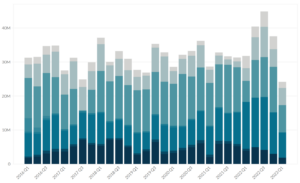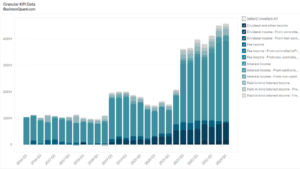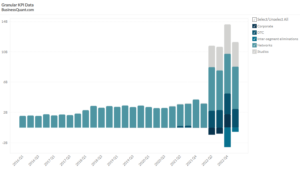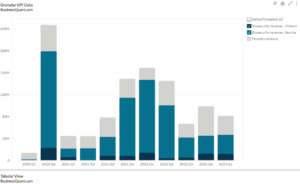
Spirit Airlines’ Load Factor (2017-2023)
Exclusive Data
You need the Pro Plan to access KPI data
- Full access to the platform
- KPI data & segment financials on US stocks
- Financial data on thousands of stocks
- Download data in xlsx and csv formats
Pro Plan
$49 per month*
60% discount ends in:
.
About
More information
Subscribe to Pro or Enterprise plans to unlock this feature.
Contact the Analyst
Subscribe to Pro or Enterprise plans to unlock this feature.
Become a smarter investor today.
Access KPIs & Segment Financials on US stocks
This statistic highlights Spirit Airlines’ Load Factor, reported on a quarterly basis from 2017 onwards.
Spirit Airlines’ Load Factor
| Period | Q1 2022 | Q2 2022 | Q3 2022 | Q4 2022 | Q1 2023 |
| Load Factor | 77.2% | 86.0% | 83.3% | 81.9% | 80.80% |
(All figures in USD, except percentages)
As per the above table, the load factor in Q3 2022 was 83.3% which was also constant in the next quarter as well. In Q1 2023, the load factor was 80.8%.
Load Factor
Load factor refers to the proportion of occupied seats on their flights. It is calculated by dividing the total number of Revenue passenger miles (RPMs)by the total number of Available seat miles (ASMs) during a specific period, usually expressed as a percentage. Revenue passenger miles represent the number of miles flown by paying passengers, while Available seat miles represent the total seating capacity available multiplied by the number of miles flown. A higher load factor indicates that a larger portion of the available seats is being filled, while a lower load factor suggests that a significant number of seats remain occupied on average.
For example, if Spirit Airlines flew 10,000,000 revenue passenger miles and had 12,000,000 available seat miles during a given period, the load factor would be calculated as follows:
Load Factor=(RPMs/ASMs) *100
Load Factor= (10,000,000/12,000,000) *100
Load Factor=83.33%
In this case, Spirit Airlines would have achieved an 83.33%load factor, indicating that, on average, approximately 83.33% of its available seats were occupied during that specific period.
A high load factor is generally desirable for airlines as it implies that they are effectively maximizing their capacity utilization and generating more revenue per flight. Operating at a high load factor allows airlines to spread their fixed costs, such as fuel, maintenance, and crew, over a large number of passengers, and achieve economies of scale.
A higher load factor can lead to a busier and potentially more crowded cabin. While this may maximize revenue, it can also impact the passenger experience in terms of seat availability, cabin, comfort, and overall satisfaction.
About Spirit Airlines
Spirit Airlines is an American ultra-low-cost carrier that operates both domestic and international flights. It was founded in 1980. Spirit Airlines is known for its no-frills approach to air travel, offering low base fares and charging additional fees for services such as checked baggage, seat selection, and in-flight refreshments. It serves more than 47 domestic destinations and 28 international destinations in 18 countries, including Colombia, Mexico, Jamaica, Aruba, Dominican, and the United States. The Spirit Airlines business model focuses on cost efficiency and customization, allowing passengers to pay for only the services they need.
Did you like Spirit Airlines’ Load Factor statistic?
Access more such KPI data points and segment financials on thousands of US stocks, with Business Quant.
You can get started here.
More data on US Stocks

Our Plans
Always know what you’ll pay. No hidden costs or surprises.
- Annual
- Monthly
60% discount till this Sunday
Pro
For serious investing
-
Company KPI data Access segment financials, non-GAAP metrics and KPI data from presentations and filings. Examples include financials by segment / region / product category, AT&T's broadband subscriber trends, Tesla's deliveries by model and lots more.
-
Stock research tools Features include : stock screener, stock comparison, industry financials, stock warnings, advanced charting tools, timeseries tables, scatter charts, financial statements, stock reports, SEC filings, stock ratings, institutional and insider ownership data. There are 200+ financial items and ratios on thousands of US stocks.
-
Industry data & tools Access premium operating data on 40+ industries. Examples include market share, smartphone shipments by vendor, subscribers by wireless carrier, historical gold production. There are 20,000+ such statistics.
Enterprise
For tailored workflows
-
All of Pro plan Get unfettered access to all our dashboards and dossiers.
-
Custom built features Get tailored dashboards built specially for you , based on your set of requirements, to simplify your research workflow.
-
Admin billing Back-end documentation support and multi-seat licensing.
* Billed annually, local taxes extra.
60% discount on Annual plan
Pro
For serious investing
-
Company KPI data Access segment financials, non-GAAP metrics and KPI data from presentations and filings. Examples include financials by segment / region / product category, AT&T's broadband subscriber trends, Tesla's deliveries by model and lots more.
-
Stock research tools Features include : stock screener, stock comparison, industry financials, stock warnings, advanced charting tools, timeseries tables, scatter charts, financial statements, stock reports, SEC filings, stock ratings, institutional and insider ownership data. There are 200+ financial items and ratios on thousands of US stocks.
-
Industry data & tools Access premium operating data on 40+ industries. Examples include market share, smartphone shipments by vendor, subscribers by wireless carrier, historical gold production. There are 20,000+ such statistics.
Enterprise
For tailored workflows
-
All of Pro plan Get unfettered access to all our features.
-
Custom built features Get tailored dashboards built specially for you , based on your set of requirements, to simplify your research workflow.
-
Admin billing Back-end documentation support and multi-seat licensing.
* Local taxes extra.






